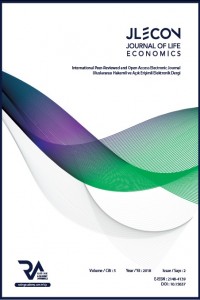Abstract
The paper investigates the relationship between the methods of funding of arts and the political nature of arts. Firstly, it is explained why state should subsidize the art production according to neo-classical economics theory. Then, various arts are classified and ordered according to their degree of politicness. Arts that depend on more written text and words, such as theater, are more political in nature compared to the arts that do not depend on written text and word, such as classical music. The relationship between art and state along with the relationship between arts and market mechanism is investigated. It is found that state and foundations subsidize the arts with low degree of politicness.
Keywords
The Degree of Politicness of Arts Arts and Politics Relationship State and Art Relationship Arts and Economics
References
- ACAR, YASİN., 2007, Tiyatro talebini belirleyen faktörlerin analizi, yayımlanmamış yüksek lisans tezi, Adnan Menderes Universitesi, Aydın. AKDEDE S. HADİ. 2013, Sanat Üretiminin Politik Ekonomi Açısından Bir Sınıflama Denemesi, Mimesis-dergi.org/2013/02/ Sanat-Üretiminin-Politik-Ekonomi-AçısındanBir-Sınıflama-Denemesi/ Arts Under Threat 2016, Annual Statistics on Censorship and Attacks on ArtisticFreedom in 2016, Freemuse publication, Sweden. BAUMOL, W. JACK. - BOWEN G. WILLIAM. 1965, On the Performing Arts: The Anatomy of Their Economic Problems. American Economic Review, 55: 495-502. BAUMOL, W. JACK. - BOWEN G. WILLIAM.,1966, Performing Arts-TheEconomic Dilemma, The Twentieth Century Fund. New York. BAUMOL, W.JACK. 1967, “Macroeconomics of unbalanced growth: The Anatomy of Urban Crises”, The American Economic Review, Vol 57, No:3415-426. BOURDİEU, PİERRE. 1984, Distinction. A Social Critique of the Judgement of Taste. Cambridge: Harvard University Press CARMİLLY-WEİNBERGER, MOSHE. 1986. Fear of Art: Censorship and Freedom of Expression in Art. Bowker, NewYork. CHİANG, TUN-JEN-POSNER, RİCHARD. A. 2006, Censorship versus freedom expression in the arts, Handbook of the Economics of Art and Culture, Volume 1, ed. Victor A. Gingsburg and David Throsby. GORDON E. SHOCKLEY., 2011, Political Environment and Policy Change: The National Endowment for the Arts in the 1990s, The Journal of Arts Management, Law, And Socıety, 41: 267–284, 2011 HANSEN, T.BILLE. 1997, The willingness-to-pay for the Royal Theatre in Copenhagen as a public good, Journal of Cultural Economics, 21: 1-28. HEIKKINEN, MERJA. 2005, Administrative Definitions of Artists in The Nordic Model of State Support for Artists, International Journal of CulturalPolicy, Vol. 11, No. 3, KATZ-GERRO, TALLY. 2002, Highbrow cultural consumption and class distinction in Italy, Israel, West Germany, Sweden, and the United States, Social Forces 81:207-229. NOGARE, CHIARA D.- GALIZZI, MATTEO M. 2011, Thepoliticaleconomy of culturalspending: evidence from Italian cities” Journal of Cultural Economics, 35:203–231. RUESCHEMEYER, MAILYN. 1997, Art, artists' associations, and the state in Norway, Journal of Arts Management, Law, and Society 27, 3; Academic Research Library, pg. 187 RUSHTON, MICHAEL 2007, Sustainable Public Funding for the Arts in the USA and Canada: Implications for Korea. Review of Cultural Economics, Vol. 10 No.1, 1-22. SCİTOVSKY, ANNE – SCITOVSKY, TIBOR, 1959, What Price Economic Progress?, Yale Review, Autumn, 49, 95-110.
Abstract
Bu makalede sanatların politiklik derecesi ile sanat üretiminin finansman biçimleri arasındaki ilişki araştırılmıştır. Öncelikle, neo-klasik ekonomi teorisine göre devletin sanatsal ürünleri neden desteklemesi gerektiği matematiksel olarak açıklanmıştır. Ardından, sanatların politiklik derecesine göre sınıflanması ve sıralanması yapılmıştır. Söze ve yazıya dayanan sanatların, tiyatro gibi, söze ve yazıya dayanmayan sanatlara göre, klasik müzik gibi daha politik olduğu vurgulanmıştır. Devlet ve sanat ilişkisi, sanat ve piyasa mekanizması ilişkisi, sanatların bu politik olma durumuna göre ayrı ayrı incelenmiştir. Devletin ve vakıflar gibi kurumların genellikle politiklik derecesi düşük sanat eserlerini veya türlerini daha çok destekledikleri örneklerle açıklanmıştır.
Keywords
Sanatların Politiklik Derecesi Sanat ve Siyaset İlişkisi Devlet Sanat İlişkisi Sanat ve Ekonomi İlişkisi Piyasa ve Sanat İlişkisi
References
- ACAR, YASİN., 2007, Tiyatro talebini belirleyen faktörlerin analizi, yayımlanmamış yüksek lisans tezi, Adnan Menderes Universitesi, Aydın. AKDEDE S. HADİ. 2013, Sanat Üretiminin Politik Ekonomi Açısından Bir Sınıflama Denemesi, Mimesis-dergi.org/2013/02/ Sanat-Üretiminin-Politik-Ekonomi-AçısındanBir-Sınıflama-Denemesi/ Arts Under Threat 2016, Annual Statistics on Censorship and Attacks on ArtisticFreedom in 2016, Freemuse publication, Sweden. BAUMOL, W. JACK. - BOWEN G. WILLIAM. 1965, On the Performing Arts: The Anatomy of Their Economic Problems. American Economic Review, 55: 495-502. BAUMOL, W. JACK. - BOWEN G. WILLIAM.,1966, Performing Arts-TheEconomic Dilemma, The Twentieth Century Fund. New York. BAUMOL, W.JACK. 1967, “Macroeconomics of unbalanced growth: The Anatomy of Urban Crises”, The American Economic Review, Vol 57, No:3415-426. BOURDİEU, PİERRE. 1984, Distinction. A Social Critique of the Judgement of Taste. Cambridge: Harvard University Press CARMİLLY-WEİNBERGER, MOSHE. 1986. Fear of Art: Censorship and Freedom of Expression in Art. Bowker, NewYork. CHİANG, TUN-JEN-POSNER, RİCHARD. A. 2006, Censorship versus freedom expression in the arts, Handbook of the Economics of Art and Culture, Volume 1, ed. Victor A. Gingsburg and David Throsby. GORDON E. SHOCKLEY., 2011, Political Environment and Policy Change: The National Endowment for the Arts in the 1990s, The Journal of Arts Management, Law, And Socıety, 41: 267–284, 2011 HANSEN, T.BILLE. 1997, The willingness-to-pay for the Royal Theatre in Copenhagen as a public good, Journal of Cultural Economics, 21: 1-28. HEIKKINEN, MERJA. 2005, Administrative Definitions of Artists in The Nordic Model of State Support for Artists, International Journal of CulturalPolicy, Vol. 11, No. 3, KATZ-GERRO, TALLY. 2002, Highbrow cultural consumption and class distinction in Italy, Israel, West Germany, Sweden, and the United States, Social Forces 81:207-229. NOGARE, CHIARA D.- GALIZZI, MATTEO M. 2011, Thepoliticaleconomy of culturalspending: evidence from Italian cities” Journal of Cultural Economics, 35:203–231. RUESCHEMEYER, MAILYN. 1997, Art, artists' associations, and the state in Norway, Journal of Arts Management, Law, and Society 27, 3; Academic Research Library, pg. 187 RUSHTON, MICHAEL 2007, Sustainable Public Funding for the Arts in the USA and Canada: Implications for Korea. Review of Cultural Economics, Vol. 10 No.1, 1-22. SCİTOVSKY, ANNE – SCITOVSKY, TIBOR, 1959, What Price Economic Progress?, Yale Review, Autumn, 49, 95-110.
Details
| Primary Language | Turkish |
|---|---|
| Journal Section | Articles |
| Authors | |
| Publication Date | April 30, 2018 |
| Published in Issue | Year 2018 Volume: 5 Issue: 2 |


